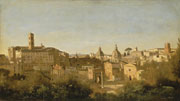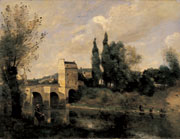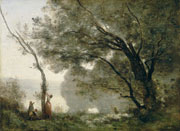|
| Nature. Emotion. Souvenir. |
20th-century
art historians chose to concentrate on certain specific aspects
of Corot’s extensive œuvre. He was thus seen as either
the heir of Neo-classical landscape or as a forerunner of Impressionism,
interpreted from the starting-point of his realist landscapes or,
in contrast, through his most refined, highly-worked Salon pieces.
The present exhibition aims to focus on all these different aspects
without opting for any one in particular. In addition, its intention
is to act as a point of departure for a revision and reassessment
of an aspect of his work which has been relatively passed over by
critics but to which Corot owed his fame in the 19th century: the
so-called Souvenirs (Recollections).
 Corot
was born in Paris to a prosperous family on 17 July 1796. He discovered
nature during his teenage years on walks around the outskirts of
Rouen. Having completed his education, Corot bowed to his family’s
wishes and started work in the textile trade, although he had already
expressed his desire to be a painter. It was not until he was 26
that his family agreed to a change of career. Corot opted for landscape
and entered the studio of Achille-Etna Michallon (1796-1822) where
he began his studies. After Michallon’s early death, he continued
in the studio of the history painter Jean-Victor Bertin (1767-1842),
remaining there for three years. In 1825 the artist made his first
trip to Italy, a country he visited on two further occasions, in
1834 and 1843. The result of these three trips was a series of urban
views and landscapes of the Campagna, depicted with notable spontaneity
and realism. Corot
was born in Paris to a prosperous family on 17 July 1796. He discovered
nature during his teenage years on walks around the outskirts of
Rouen. Having completed his education, Corot bowed to his family’s
wishes and started work in the textile trade, although he had already
expressed his desire to be a painter. It was not until he was 26
that his family agreed to a change of career. Corot opted for landscape
and entered the studio of Achille-Etna Michallon (1796-1822) where
he began his studies. After Michallon’s early death, he continued
in the studio of the history painter Jean-Victor Bertin (1767-1842),
remaining there for three years. In 1825 the artist made his first
trip to Italy, a country he visited on two further occasions, in
1834 and 1843. The result of these three trips was a series of urban
views and landscapes of the Campagna, depicted with notable spontaneity
and realism.
 In
1827, while still in Italy, Corot exhibited at the Salon for the
first time, showing two landscapes. He would continue to exhibit
there regularly throughout his career, and was a member of its admission
committee. Running parallel to his interest in landscape was the
artist’s exploration of the human figure, and his first nudes
date from 1837. In the 1850s, Corot was at the peak of his career,
enjoying critical and popular renown. He maintained his creative
powers until the end of his life, dying in Paris in 1875 aged 79. In
1827, while still in Italy, Corot exhibited at the Salon for the
first time, showing two landscapes. He would continue to exhibit
there regularly throughout his career, and was a member of its admission
committee. Running parallel to his interest in landscape was the
artist’s exploration of the human figure, and his first nudes
date from 1837. In the 1850s, Corot was at the peak of his career,
enjoying critical and popular renown. He maintained his creative
powers until the end of his life, dying in Paris in 1875 aged 79.
 Corot.
Nature, Emotion, Souvenir brings together more than 80 oil
paintings in the first retrospective exhibition to be devoted to
the artist in Spain. Its intention is to offer a complete and coherent
overview of his work through the two genres to which he remained
faithful throughout his career: landscape and the figure. The works
on show –which include some of the artist’s most legendary
paintings, now iconic images– are organised into sections.
These are devoted to his early
years; to realist landscape (the sections
entitled Italy,
The Regions of France,
and Realism);
to nature transformed through the artist’s imagination (the
sections entitled From
historical to lyrical Landscape and Ville-d’Avray);
to the figures,
and to the souvenirs (Recollections).
The latter are imbued with the poetic aesthetic through which Corot
expressed his own emotions. Corot.
Nature, Emotion, Souvenir brings together more than 80 oil
paintings in the first retrospective exhibition to be devoted to
the artist in Spain. Its intention is to offer a complete and coherent
overview of his work through the two genres to which he remained
faithful throughout his career: landscape and the figure. The works
on show –which include some of the artist’s most legendary
paintings, now iconic images– are organised into sections.
These are devoted to his early
years; to realist landscape (the sections
entitled Italy,
The Regions of France,
and Realism);
to nature transformed through the artist’s imagination (the
sections entitled From
historical to lyrical Landscape and Ville-d’Avray);
to the figures,
and to the souvenirs (Recollections).
The latter are imbued with the poetic aesthetic through which Corot
expressed his own emotions.
|
|
 Corot
was born in Paris to a prosperous family on 17 July 1796. He discovered
nature during his teenage years on walks around the outskirts of
Rouen. Having completed his education, Corot bowed to his family’s
wishes and started work in the textile trade, although he had already
expressed his desire to be a painter. It was not until he was 26
that his family agreed to a change of career. Corot opted for landscape
and entered the studio of Achille-Etna Michallon (1796-1822) where
he began his studies. After Michallon’s early death, he continued
in the studio of the history painter Jean-Victor Bertin (1767-1842),
remaining there for three years. In 1825 the artist made his first
trip to Italy, a country he visited on two further occasions, in
1834 and 1843. The result of these three trips was a series of urban
views and landscapes of the Campagna, depicted with notable spontaneity
and realism.
Corot
was born in Paris to a prosperous family on 17 July 1796. He discovered
nature during his teenage years on walks around the outskirts of
Rouen. Having completed his education, Corot bowed to his family’s
wishes and started work in the textile trade, although he had already
expressed his desire to be a painter. It was not until he was 26
that his family agreed to a change of career. Corot opted for landscape
and entered the studio of Achille-Etna Michallon (1796-1822) where
he began his studies. After Michallon’s early death, he continued
in the studio of the history painter Jean-Victor Bertin (1767-1842),
remaining there for three years. In 1825 the artist made his first
trip to Italy, a country he visited on two further occasions, in
1834 and 1843. The result of these three trips was a series of urban
views and landscapes of the Campagna, depicted with notable spontaneity
and realism. In
1827, while still in Italy, Corot exhibited at the Salon for the
first time, showing two landscapes. He would continue to exhibit
there regularly throughout his career, and was a member of its admission
committee. Running parallel to his interest in landscape was the
artist’s exploration of the human figure, and his first nudes
date from 1837. In the 1850s, Corot was at the peak of his career,
enjoying critical and popular renown. He maintained his creative
powers until the end of his life, dying in Paris in 1875 aged 79.
In
1827, while still in Italy, Corot exhibited at the Salon for the
first time, showing two landscapes. He would continue to exhibit
there regularly throughout his career, and was a member of its admission
committee. Running parallel to his interest in landscape was the
artist’s exploration of the human figure, and his first nudes
date from 1837. In the 1850s, Corot was at the peak of his career,
enjoying critical and popular renown. He maintained his creative
powers until the end of his life, dying in Paris in 1875 aged 79. Corot.
Nature, Emotion, Souvenir brings together more than 80 oil
paintings in the first retrospective exhibition to be devoted to
the artist in Spain. Its intention is to offer a complete and coherent
overview of his work through the two genres to which he remained
faithful throughout his career: landscape and the figure. The works
on show –which include some of the artist’s most legendary
paintings, now iconic images– are organised into sections.
These are devoted to his early
years; to realist landscape (the sections
entitled Italy,
The Regions of France,
and Realism);
to nature transformed through the artist’s imagination (the
sections entitled From
historical to lyrical Landscape and Ville-d’Avray);
to the figures,
and to the souvenirs (Recollections).
The latter are imbued with the poetic aesthetic through which Corot
expressed his own emotions.
Corot.
Nature, Emotion, Souvenir brings together more than 80 oil
paintings in the first retrospective exhibition to be devoted to
the artist in Spain. Its intention is to offer a complete and coherent
overview of his work through the two genres to which he remained
faithful throughout his career: landscape and the figure. The works
on show –which include some of the artist’s most legendary
paintings, now iconic images– are organised into sections.
These are devoted to his early
years; to realist landscape (the sections
entitled Italy,
The Regions of France,
and Realism);
to nature transformed through the artist’s imagination (the
sections entitled From
historical to lyrical Landscape and Ville-d’Avray);
to the figures,
and to the souvenirs (Recollections).
The latter are imbued with the poetic aesthetic through which Corot
expressed his own emotions.